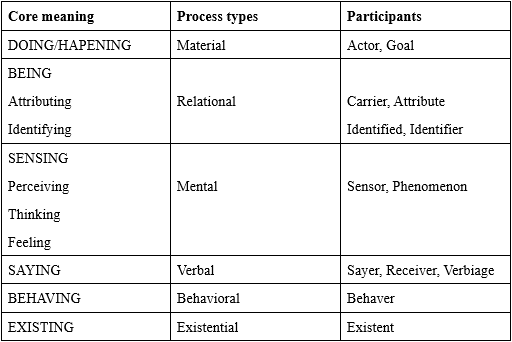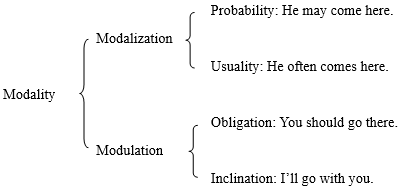Chapter 1
 5.5 Systemic-functional grammar
5.5 Systemic-functional grammar
I.Brainstorming
There is one of greatest linguist who is M. A. K. Halliday. Do you know anything about him?
II. Systemic-functional grammar—M. A. K. Halliday
1. Two perspectives of syntactic analysis: chain and choice
Chain/syntagmatic relation: we analyze sentences by looking into their constituent and generalizing the pattern, we start from the perspectives of form.
Choice/paradigmatic relation: if a linguist is interested in use, he/she will explore relations and endeavors to find what are the options and what factors affect the speakers’ choices
2. The goal and content of systemic-functional grammar
The goal of systemic-functional grammar is to see how function and meaning are realized through forms.
Systemic-functional grammar starts from the perspectives of function and meaning in analyzing sentences. It views languages as a system of meaning potentials and sentence structure as result of a process of selection. The grammatical system of any language is a system of options. The form of language is realization of function. The task of functional grammar is to account for the intricate relation of function to form.
3. The three meta-functions of language
Ideational function
Language serves as a coding system which deals the relation between man and nature. We use language to talk about our experience of the world, including our inner world, to describe events, states and the entities involved.
Interpersonal function
Language serves as a medium between individuals. We use language to interact with others, to establish and maintain relations with them, to please them, to anger them, and influence their behavior, to get their help or sympathy them.
Textual function
Language as a system organizes message in a unified manner so that chunks of message fit logically with them and around them and with a wider context in which talking and writing takes places.
4. The transitivity system of language
The ideational function is realized by the transitivity system of language. In systemic—functional grammar, transitivity is a quality of a verb which can take an object. It is a type of linguistic process which represents what exists and what is going on around us and inside us.
The reality is categorized into DOING, BEING (the physical world) and SENSING (the world of consciousness).
1) Doing – material process
Processes involving physical actions: walking, running, throwing, kicking, wrapping, etc. A material process usually involves an actor. In many cases, the action is represented as affecting or “being done to” the goal, an object or person to which the action is directed. Some material process also involves circumstance, which essentially encodes the background of action.
E.g.

A material process is a linguistic process is a linguistic process that represents doing. The doer may or may not be the subject of the sentence. Both the actor and the goal are participants of the process.
2) Being – relational process
Relational processes are linguistic processes that represent a relation being set up between two separate entities. In relational processes, something is said to be (or to have) and something else or to be of some quality. They fall into two distinct modes: attributive and identifying.
Relational processes are often expressed by the verb be or have. In representing possessive relations, the verb have is attributive, while the verb be is identifying.
e.g. Tom has a motorcycle.
Tom is the leader.
3) Sensing – mental process
Processes of sensing, including feeling, thinking, perceiving, imagining, wanting, liking, etc. a mental process involves the sensor (a human participant in whose mind the process occurs) and the phenomenon which triggers the process.
e.g.

Sensor is normally is a person or a personified entity. The verb representing a mental process is generally in a simple present or past tense, not in a progressive form because the process of sensing is not a process of doing.
4) Verbal processes – saying something
Verbal process is between material processes and mental processes. Saying something is both a physical action and a mental activity. There is participant involved in any verbal process—the Sayer. Typically the sayer is a human. That can be another participant involved, the Receiver, typically also human. The message is called the Verbiage.

5) Behavioral processes – active conscious processes
Behavioral processes are between mental processes and material processes. They are close to mental processes, but they reflect an active conscious process. Verbs representing behavioral processes can be used in progressive forms, while verbs expressive mental cannot. Typically, behavioral processes have only one behaver. In some case, there is a quasi—participant called Ranger.

6) Existential processes – existence of an entity
Existential processes express the mere existence of an entity. There is only one participant in such syntactic structure, called the existent. The word “there” has no specific meaning. Usually, a circumstance is involved.

7) Summary

5. Mood and modality
The interpersonal function is fulfilled by the mood and modality.
Mood
Mood expresses the speaker’s attitude and serves for interpersonal function. It is a syntactic constituent made up of the subject and the finite. The subject is the first noun or phrase in a statement. The finite is a verbal operator that express tense (e.g. is was, have. had) or modal meaning (e.g. should, can, must) as well as positive or negative form. The reminder is called residue.

Modality and polarity:
The finite expresses not only tense but also polarity and modality. Any finite expresses polarity because it is either positive or negative (however, polarity may be expressed by never, hardly, etc.). The semantic space between “yes” and “no” is pressed by modality. Modality can be categorized by modalization and modulation.
Modalization: how valid the information is in terms of probability (how likely it is) or usuality (how frequent it is).
Modulation: the of obligation on the person to carry out the commands; the drgree of inclination of the speaker to fulfill the offer.

6. Theme and rheme
Textual function is realized by theme and rheme at the clause level.
Definition:
The constituent that stands for the starting point for the message is termed as theme. All the rest of the sentence is labeled rheme. Theme is the given information, while rheme is the new information. Theme may or may not be the subject of the sentence.

Classification of theme
The theme is conflated with the subject is said to be unmarked theme.
The constituent of the sentence is selected as the starting point of the message is called as marked theme.
If the starting point for the message is emphasized by the pattern “it is …that/who/which…”, the theme is termed as predicated theme.
If the starting point is a comment in the form of “it is…”, the theme is called thematic comment.
III. Classification of theme
According to Halliday’s systemic-functional grammar, language is a system of meaning potential and a network of meaning as choices. Meaning determines form, not vice versa. Meaning is realized through forms.
